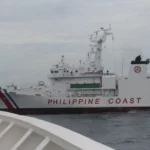A junior officer’s failure to complete a landing checklist during a specialized maneuver last year caused a fifth-generation fighter to crash into an aircraft carrier, injuring six sailors and destroying the $115.3 million jet, the Navy determined.
The pilot, an unnamed lieutenant assigned to Strike Fighter Squadron 147, failed to complete his checklist before attempting to land the F-35C Lightning II aboard the USS Carl Vinson on Jan. 24, 2022, according to the accident investigation report provided to Stars and Stripes on Thursday by Naval Air Forces Pacific spokesman Cmdr. Zachary Harrell.
As a result, the pilot failed to transition from a manual control mode to automatic, the F-35C did not behave as he expected and it subsequently crashed onto the flight deck, according to the report.
Video footage of the crash leaked on social media in February 2022 shows the fifth-generation fighter striking the Carl Vinson’s deck, bursting into flames and skidding across the deck before falling into the South China Sea.
The Navy recovered the jet from the ocean floor on March 2, 2022, more than a month after the crash.
On his approach, the pilot attempted an expedited recovery maneuver, also referred to as a “Sierra Hotel Break” by pilots. However, his “lack of familiarity” with the maneuver and the loss of “situational awareness” led to the crash, Vice Adm. Karl Thomas, 7th Fleet commander, said in the report.
“This mishap was the result of pilot error,” Thomas wrote in his endorsement. “The mishap pilot (MP) attempted an expedited recovery breaking overhead the carrier, an approved and common maneuver, but the MP had never performed this maneuver before and it reduced the amount of time to configure the aircraft and conduct landing checks.”
During an expedited recovery maneuver, pilots use gravity to rapidly decelerate their aircraft during a 360-degree turn before landing on an aircraft carrier; the maneuver can reduce the time necessary to recover an aircraft, according to the report.
During this maneuver, however, the pilot failed to transition from a manual control mode to an automated one. Unaware of this mistake, the pilot’s subsequent adjustments and corrections to the aircraft’s thrusts were not what he expected, according to the report.
A signal officer attempted to wave off the pilot, but the aircraft crashed into the flight deck just four seconds later.
The impact cut the F-35C’s main landing gear and bounced its tail into the air; the landing deck’s arresting wire caught one of the fighter’s air-to-air missile brackets. The jet ultimately began a counterclockwise spin that continued until it fell off the deck and into the ocean.
Crash debris injured four sailors on the flight deck and another on the landing signal officer platform; the pilot was also hurt.
The impact and debris caused millions of dollars in damages. Debris struck a nearby EA-18G Growler, resulting in $2.3 million in damage; another $120,000 in damage was done to the carrier’s deck.
And the F-35C, which the report said was purchased for $115.3 million, was “struck from the inventory.”
As a result of the investigation, Vice Adm. Kenneth Whitesell, commander of Naval Air Forces, made several recommendations, including the development of helmet-mounted indicators for pilots and external indicators for signal officers to notify them that an aircraft does not have the automated command mode during a landing approach.
The Field Naval Aviator Evaluation Board determined during the investigation that expedited recovery maneuvers should not be banned because, although it was a factor in the crash, the primary cause was the pilot’s failure to switch command modes.
The pilot, meanwhile, has been removed from flight status but remains in the Navy, USNI reported on Tuesday, citing an unnamed Navy spokesman.
source: stripes















